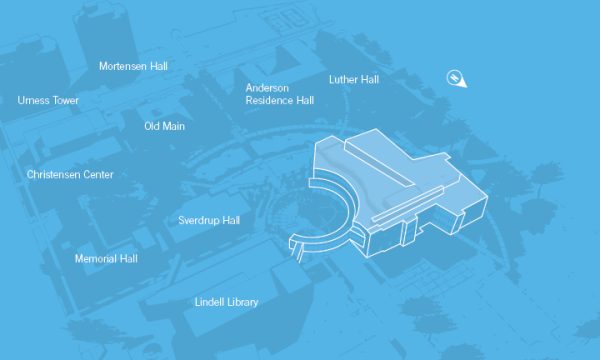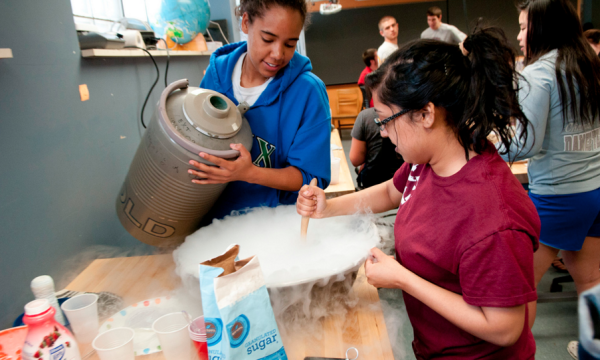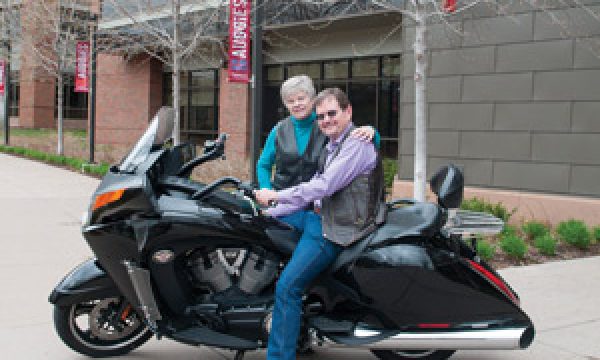Twenty-three acres. That’s the area of Augsburg’s Minneapolis campus—roughly the size of 21 football fields.
As an urban college, Augsburg recognizes that thoughtful stewardship of this finite resource is critical to its success in serving students and providing an affordable, high-quality educational experience.
That’s why, in 2010, a cross-functional team—including faculty, staff, and outside consultants—established the Augsburg Campus Space and Master Plan. This 20-year strategic vision for the use, reuse, and improvement of Augsburg’s nineblock urban campus identifies and integrates near-term priorities with future construction plans. The result is a logical, cohesive progression of projects and enhancements that work in concert to enable the College to achieve its long-term vision for the campus.
“How we use our space is part of how we express our priorities and tell our story—how we live out our mission and promise to students,” said Tammy McGee, Augsburg vice president and chief financial officer.
“One of the core tenets of the Campus Space and Master Plan is that Augsburg College, in its current footprint, has enough space to deliver on its mission,” said McGee, who led the year-long planning commission effort. The focus of the long-term plan is on stewardship—“building to replace, fix, or improve our spaces, not necessarily to have more space,” she said.
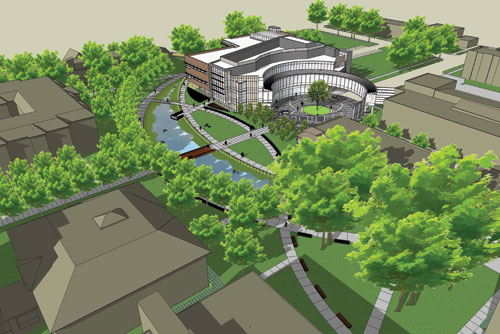
The master plan’s focus on student experience is evident in that it is built around the College’s No. 1 campus priority: the planned Center for Science, Business, and Religion. The center will be constructed on the west side of 21st Avenue South, across from the James G. Lindell Library, replacing the existing Science Hall, which was built in 1949.
“Augsburg’s vision for the Center for Science, Business, and Religion is a physical manifestation of the interdisciplinary inquiry and critical thinking our faculty bring into classroom and lab experiences every day,” said Barbara Farley, vice president of academic affairs and dean of the College.
“Augsburg believes that co-locating and fostering deep inquiry across these academic disciplines will prepare our students to be the problem solvers, leaders, and citizens our community and nation will need in the 21st century.”
While the College continues the fundraising effort for the Center for Science, Business, and Religion, the campus master plan guides progress on other campus and interior space improvements that help prepare for and complement the new building.
One of the main goals in improving campus space usage, according to David Draus, Augsburg Facilities Management director, is to create adjacencies—locating departments that work together near each other to help improve their effectiveness.
A prime example of this work was the Gage Center for Student Success and Groves Technology Center, which opened in the spring of 2012, co-locating a range of student support services at the heart of campus. (See “Gage Center for Student Success” in the summer 2012 Augsburg Now.) Following this model, the College moved its career and internship services staff into the newly renovated Clair and Gladys Strommen Center for Meaningful Work this summer.
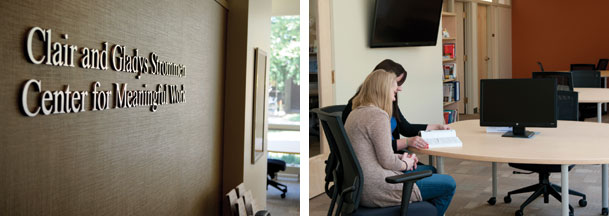
“Because of the vision and generosity of the Strommen, Gage, and Groves families, Augsburg was able to enter this academic year with two new, beautiful spaces dedicated to serving students throughout their educational journeys and beyond,” said Augsburg President Paul C. Pribbenow. “By locating these centers in such highly visible, high-traffic areas, we expect a dramatic increase in the number of students who will take advantage of the academic and career services Augsburg offers.”
With the opening of the Gage Center, several student support departments moved out of Science Hall, which, Draus said, opened up space for additional moves that better support student and department needs. For example, Augsburg’s signature Undergraduate Research and Graduate Opportunity (URGO) program moved to a larger space in Science Hall, and that shift enabled the College to expand its psychology labs and to add student and faculty space in mathematics and environmental studies. The Department of Nursing also moved to Science Hall—at least until that building is ready to be razed—as the department had outgrown its former suite in Memorial Hall.
“As much as is possible with these moves, we are working to minimize the amount of disruption and relocation that will be required when the Center for Science, Business, and Religion is built,” Draus said. URGO, psychology, mathematics, and environmental studies are all slated to move out of Science Hall to the new Center once it is built.
The College’s space upgrades also include several high-profile projects in Christensen Center. This past fall, the College moved all of its admissions operations—first-year, transfer, adult undergraduate, and graduate—together in a welcoming new suite in the lower level of Christensen Center, creating a warm and engaging first impression for visiting prospective students and their families. This move also created important adjacencies. With the new Strommen Center for Meaningful Work just upstairs from the Office of Admissions, campus tours now “begin with the end in mind” by talking with families about how the entire Augsburg educational experience prepares students for postgraduate and lifelong learning and success.
As with the Gage Center, co-locating the admissions teams created additional opportunities for repurposing space in Christensen Center. One of the major results was a newly refurbished suite for Augsburg Abroad, the International Student and Scholar Services team, and the College’s multicultural student services directors. The new location for these groups is just down the hall from the admissions office and the Campus Activities and Orientation department. So now, the admissions team can easily introduce prospective students to staff and programs that support some of the major life-changing opportunities that a college experience provides.
Augsburg Abroad, International Student and Scholar Services, and the multicultural student services directors previously were housed in Murphy Place, which was originally built in 1964 as a temporary structure across 7½ Avenue from Murphy Square park. With those groups now in Christensen Center and Augsburg’s Center for Global Education relocated in the Anderson Hall suite that formerly housed the Strommen Center, Murphy Place was vacated and, as outlined in the Campus Space and Master Plan, was scheduled to be razed. The campus master plan does not call for developing the land where Murphy Place previously stood until other, higher-priority construction projects are completed, but it does outline a long-term vision for creating a green-space gathering area in that location.
While there certainly were numerous changes on campus in the past year, not all campus improvements involve relocation.
“Many of the improvements involved upgrading furniture to foster more collaboration and interaction in existing spaces,” said Matt Rumpza, director of Purchasing and Central Support Services. Two examples of these kinds of upgrades include the casual learning spaces in Old Main and outside the Enrollment Center—a centralized services location where students can meet with a financial aid counselor, process late registrations, and work with the Registrar’s office to finalize their graduation application.
“We also did significant renovations in Hoversten Chapel,” Rumpza said. Upgrades included introducing a new sound system, recarpeting the stage risers, and refurbishing the chairs for the chapel and nearby Tjornhom- Nelson Theater. “Rather than throw the existing 600 chairs into a landfill, we were able to hire a locally owned business to recover and refurbish them,” Rumpza said. “We get a refreshed look for our chapel while supporting the vitality of our neighborhood.”
Clair and Gladys Strommen Center for Meaningful Work moves to campus center
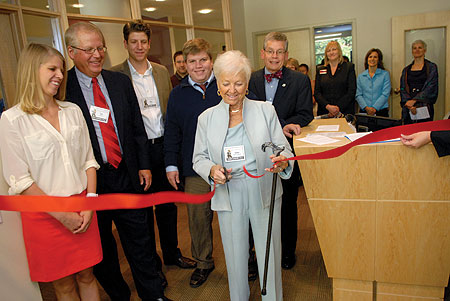
“Meaningful work, or discerning one’s vocational calling, is not just about being successful in one’s career,” said Amy Gort, assistant vice president and dean of arts and sciences. “Vocation is about developing and using your gifts to serve others. So, it involves understanding not only your own strengths but also the larger context of where those talents and strengths can best be put to use. This exploration is an important part of what makes an Augsburg education unique.”
“This Center is a place where students, both past and present, can get the assistance they need” in finding meaningful work, said Gladys Strommen, who spoke at the grand opening ceremony. “Four generations of the Strommen family have been part of Augsburg,” she said. “Clair [Gladys’ husband, who passed away in 2001 ] would be so pleased that this Center has become a reality.”
Clair and Gladys’ son, Bob Strommen, also spoke at the dedication event, honoring the work his mother has done over the years to fulfill the dreams of both of his parents. “The gift [to fund the relocation of the Center] was an event, but the hope is that the Center will be a journey—for the College, as well as for faculty, staff, students, and alumni. We all come [to college] for an education,” he said, “but the dream is to leave and have a meaningful life. To help our students have an impact on what’s important to them in their lives—that’s our hope for this Center.”


